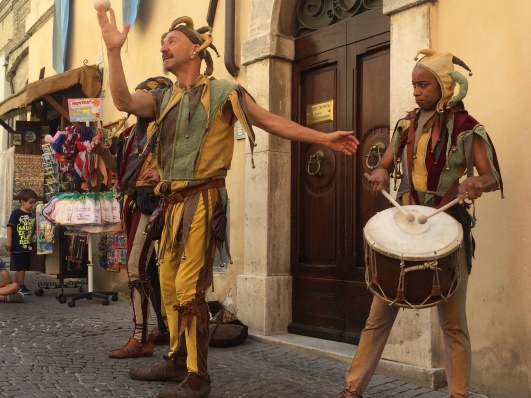There’s something special about Bevagna. Unlike most medieval Italian towns it’s not situated imposingly on a hill but lies in a vast plain in the center of Umbria far from major roads and the sights that attract tourists to the region. The town of barely 2,000 can trace its origins to Roman antiquity but its the Middle Ages that left the greatest impact and which are still visible today in the squares, churches and gates that mark the entrance to this historically homogenous town.

Anytime is a good time to visit Bevagna but if you arrive in mid-June you’ll have the pleasure of experiencing the annual Mercato delle Gaite festival and may wonder what century it is. The Gaite are the four neigborhoods which make up the town (San Giorgio, San Giovanni, Santa Maria and San Pietro) and that compete in a medieval reconstruction where attention to detail is the goal. Locals take the two-week event very seriously and may even refuse to speak with friends and family from a different Gaite throughout the duration of the event.

Nearly everyone participates and preparations begin months in advance. Each neighborhood demonstrates the working practices of two medieval professions, operates a tavern and takes part in the archery competition. Points are assigned by university professors who meticulously judge the reenactment and a winner is announced on the final Sunday.

Tasting medieval recipes with modern twists is one of the highlights of the Mercato delle Gaite. Maps are available from the outdoor information table in Piazza Silvestri to help navigate the town and locate eateries. Each tavern has a booth near the entrance where orders are placed and paid for before sitting down at the wooden benches and tables set up in the small squares or along pedestrian streets. Shade is a priority during the day and the San Pietro tavern with its large oak tree is a pleasant reprieve from the hot Umbrian sun. Food is served by costumed teenagers and portions are generous. Besides the taverns there are locanda which are even less expensive and provide a selection of grilled meats served with wine and beer and little thought to formality.

Each neighborhood also demonstrates two mestiere or professions. Visitors can decide how many to visit and tickets are available from each workshop. The paper makers (San Giovanni) with a working mill and dyers (San Pietro) are particular interesting and faithfully demonstrate the intricate production process. The end products of these workshops and many other goods are on display and available for sale at the markets which take place on the final weekend of the festival. That’s is the busiest and most animated time when streets are filled to capacity and jesters, musicians, fire eaters, historical processions and archers hoping to shoot their gaite to victory fill Bevagna with a wonderful medieval spirit.
Your Guide to Italy:
Moon: Rome, Florence & Venice
